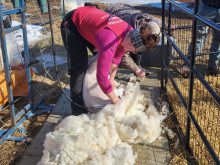RED DEER – You can lead a horse to feed, but you can’t make him eat.
Horses need 14 essential minerals for good health but ensuring they get them is the challenge, said an equine specialist from the University of Kentucky.
“If you are feeding a reasonable quality forage, you are probably going to meet those requirements. It is not something you have to worry about nearly as much as you think,” said Bill Coleman. He spoke at the annual Alberta Horse Breeders and Owners conference in Red Deer attended by more than 800 people on Jan. 11-12.
Read Also

Charges laid after cattle theft
Saskatchewan RCMP lay two charges against a man after six cattle went missing.
The recommended minimum levels for minerals are published in the 1989 National Research Council animal nutrition guidelines.
When calculating mineral intake, the entire diet is considered, not the individual feeds making up part of the whole ration. As more is known about horse nutrition, some of the guidelines could be raised to allow for higher levels of some nutrients.
The major minerals are calcium, phosphorus, sodium chloride, potassium, magnesium and sulfur. Many of these can be included in a salt block. Horses will seek out salt but each animal has individual tastes and levels of consumption are hard to measure.
And, like people, some horses take too much salt but it is difficult to measure adverse effects because it is not known how much the animal eats each day.
Some horses need higher than average supplementation, depending on their workload. High performance horses often require supplements to maintain potassium levels lost in sweat and urine.
They also need proper measures of calcium and phosphorous for bone density and strength.
Nutrition guidelines say a two-to-one ratio of calcium to phosphorus is needed for proper bones. However, many horses take in far more calcium than guidelines suggest because of its availability in forages.
Alfalfa for example, is an excellent source of calcium for horses. It often contains far more than the horse needs.
Young horses may need to ingest a three-to-one ratio of calcium so they can withstand vigorous training while they are still growing.
“We do see changes in bone density with training. We will actually get a decrease in bone density as you are conditioning the horse,” said Coleman.
Trace minerals such as copper, zinc, selenium and manganese are also necessary for growth and maintenance.
Selenium and copper tends to be deficient in western Canadian soils so forages are deficient. Supplementation may be required, but feeds should be tested because some locales have sufficient or more selenium than required. An overdose of a mineral like selenium is toxic for horses.
However, people often believe more is better and could actually give their animals too much and cause a nutritional imbalance.
Selenium requirements for a horse are between .01 to .03 milligrams per kilogram of weight. It is toxic at levels greater than two mg.
Horses need copper at a rate of 10 mg per kg of weight. Developmental orthopedic disease and copper deficiency are linked. A recent study showed young horses and brood mares can handle higher doses at 20-25 mg per kg of weight. If it is fed to a pregnant mare throughout gestation, its foal is less likely to suffer from this crippling bone condition.
These minerals can be delivered in block or as loose minerals and should be placed where the horses are likely to eat them.
It should not be assumed a horse does not need a particular nutrient because it does not eat it. It may not like the taste of a particular feed or mineral supplement. Or, if it is frigid outside, a horse may refuse to lick a cold block of salt.
A block of salt weighing 20 kg should last 333 days. Horses will consume about 60 grams per animal per day of loose minerals.
“If it is going faster, maybe we need to check,” Coleman said.
Environmental conditions have some impact on horse nutrition. If well water has a high mineral content, it is not wise to cut back on supplements because it is difficult to measure how much water a horse drinks.
High sulfur levels in water can tie up copper usage and cause a deficiency. Additional dietary copper may be needed if there is a risk of deficiency. In areas with saline water, put a block of salt out anyway. Salt intake will likely be lower.

















